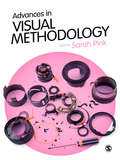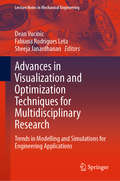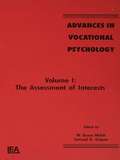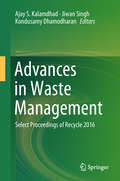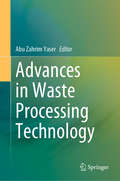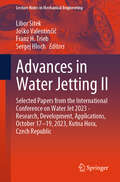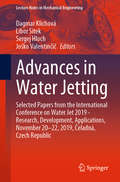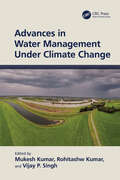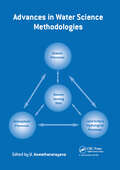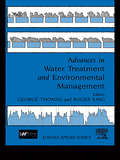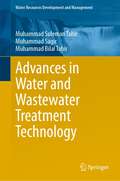- Table View
- List View
Advances in Visual Methodology
by Sarah PinkA stunning collection of cutting-edge essays which brings together the leading scholars in visual research. Clearly structured, and written in an engaging and accessible style throughout, this invigorating work will be the 'must have' text for teachers and students of `the visual' across the arts, humanities and social sciences. - Elaine Campbell, Reader in Criminology, Newcastle University This is a book about research that takes the challenge of the internet seriously, that rises above disciplinary difference and points to new directions for social research. - Rob Walker, Emeritus Professor, University of East Anglia This innovative book examines and introduces cutting edge visual methods in social research. It explores the development of visual methodology as a field of interdisciplinary and post-disciplinary practice spanning scholarly and applied concerns. Positioned at the innovative edge of theory and practice in contemporary visual research, Pink's engaging book goes beyond the methods, ideas and fields of practice outlined in existing texts and handbooks. This book examines: -How new theoretical and methodological engagements are developing and emerging in research practice; -the impact new approaches are having on the types of knowledge visual research produces and critiques; -the ways visual research intersects with new media; -and the implications for social and cultural research, scholarship and intervention. This book will be essential reading for any student or researcher thinking of using visual methods in their own research. Sarah Pink is Professor of Social Sciences at Loughborough University.
Advances in Visualization and Optimization Techniques for Multidisciplinary Research: Trends in Modelling and Simulations for Engineering Applications (Lecture Notes in Mechanical Engineering)
by Fabiana Rodrigues Leta Dean Vucinic Sheeja JanardhananThis volume presents several multidisciplinary approaches to the visual representation of data acquired from experiments. As an expansion of these approaches, it is also possible to include data examination generated by mathematical-physical modeling. Imaging Systems encompass any subject related to digital images, from fundamental requirements for a correct image acquisition to computational algorithms that make it possible to obtain relevant information for image analysis. In this context, the book presents selected contributions of a special session at the Conference on Advanced Computational Engineering and Experimenting (ACE-X) 2016.
Advances in Vocational Psychology: Volume 1: the Assessment of interests (Contemporary Topics in Vocational Psychology Series)
by W. Bruce Walsh, Samuel H. OsipowAdvances in Vocational Psychology devoted to presenting and evaluating important advances in the field of interest measurement. Progress in three well known interest inventories -- the Strong Campbell Interest Inventory, the Kuder Occupational Interest Survey, and the Self Directed Search -- is closely examined. A focus on innovations in interest measurement directs attention to how more recent instruments provide technical and conceptual advances over older, more reliable ones. Both research and counseling perspectives combine to provide a well-balanced guide to the study of vocational psychology. How interest inventories can be used beneficially in the career counseling of minority and majority populations is also explored.
Advances in Waste Management: Proceedings of the International Conference on Advances and Innovations in Recycling Engineering (AIR-2021) (Lecture Notes in Civil Engineering #301)
by N. A. Siddiqui Prasenjit Mondal Akmalov Shamshodbek Baxtiyarovich Abhishek NandanThis book comprises papers from the International Conference on Advances and Innovations in Recycling Engineering (AIR-2021). It highlights indispensable issues, challenges, and recommended solutions related to solid waste management and sustainability. The contents deal with recommended solutions and the gap between environmental laws related to recycling of waste and environment threat. Weighing the global economy loss via compromises on industrial growth versus environment provides another dimension to the study and press on the need for alternative practices. The impact on biodiversity conservation and natural resources pollutants is also highlighted. This book will be a useful guide for academics, researchers, and policymakers working in the fields of waste management.
Advances in Waste Management: Select Proceedings of Recycle 2016
by Ajay S. Kalamdhad Jiwan Singh Kondusamy DhamodharanThis book presents some of the latest technologies in waste management, and emphasizes the benefits that can be gained from the use of recycled products. Divided into four sections, it deals with phytoremediation, acquatic weed management and the treatment of solid- and water-based wastes, such as those arising from agricultural, industrial and medical activities. With its special emphasis on the utilization of recycled products, this volume will be of interest to students, academicians, policy makers and others who have a practical and academic interest in dealing with the waste society generates.
Advances in Waste Processing Technology
by Abu Zahrim YaserThis book highlights the latest research on waste processing technologies, particularly for domestic, agricultural, and petroleum based pollutants, intended to achieve waste valorisation. In addition, it discusses the important role of plastic recycling, as well as advanced waste processing techniques.
Advances in Waste-to-Energy Technologies
by Rajeev Pratap Singh Vishal Prasad Barkha VaishAs global populations continue to increase, the application of biotechnological processes for disposal and control of waste has gained importance in recent years. Advances in Waste-to-Energy Technologies presents the latest developments in the areas of solid waste management, Waste-to-Energy (WTE) technologies, biotechnological approaches, and their global challenges. It combines biotechnological procedures, sophisticated modeling, and techno-economic analysis of waste, and examines the current need for the maximum recovery of energy from wastes as well as the associated biotechnological and environmental impacts. Features: Presents numerous waste management practices and methods to recover resources from waste using the best biotechnological approaches available. Addresses the challenges, management, and policy issues of waste management and WTE initiatives. Includes practical case studies from around the world. Serves as a useful resource for professionals and students involved in cross-disciplinary and trans-disciplinary research programs and related courses. Discusses the economic and regulatory contexts for managing waste. This book will serve as a valuable reference for researchers, academicians, municipal authorities, government bodies, waste managers, building engineers, and environmental consultants requiring an understanding of waste management and the latest WTE technologies.
Advances in Water Desalination (Advances in Water Desalination #1)
by Noam LiorDesalination is a dynamically growing field with more research, more engineering, more applications, more countries, more people, and with more training programs. This book provides high quality invited reviews on progress in various aspects of the desalination field. It features comprehensive coverage of desalination science, technology, economics, markets, energy considerations, environmental impact, and more. It is a key guide for professionals and researchers in water desalination and related areas including chemical, mechanical, and civil engineers, chemists, materials scientists, manufacturers of desalination membranes, water reuse engineers, and water authorities, as well as students in these fields.
Advances in Water Jetting II: Selected Papers from the International Conference on Water Jet 2023 - Research, Development, Applications, October 17-19, 2023, Kutna Hora, Czech Republic (Lecture Notes in Mechanical Engineering)
by Sergej Hloch Libor Sitek Joško Valentinčič Franz H. TriebThis book gathers selected, peer-reviewed contributions to the international conference on Water Jet 2023 (WJ2023), organized by the Institute of Geonics of the Czech Academy of Sciences. It covers research and developments of water jets, and their applications in cutting, machining, cleaning, surface treatment, and milling. Further topics include the use of water jets in the removal of coatings and layers, jet grouting, jet observation and parameters measurement. Moreover, erosion wear, environmental aspects of water jets and their improvement with particular emphasis on sustainable practices, are also discussed. Overall, this book provides academics and practitioners with extensive information on state-of-the-art theories and methods that can be used to understand, analyse and improve the rapidly growing field high-velocity water jet technology.
Advances in Water Jetting: Selected Papers from the International Conference on Water Jet 2019 - Research, Development, Applications, November 20-22, 2019, Čeladná, Czech Republic (Lecture Notes in Mechanical Engineering)
by Sergej Hloch Dagmar Klichová Libor Sitek Joško ValentinčičThis book reports on recent advances in the rapidly growing field of high-speed water jet technology, discussing research, developments and applications related to cutting, machining, repair of structures and buildings, cleaning, removal of coatings and layers, mining, and abrasive materials. It also explores special applications of high-pressure techniques, as well as important environmental aspects and solutions for technology transfer. Thanks to the balance of theory and practical findings, the book offers a timely snapshot for researchers and industrial communities alike, and a platform to facilitate communication and collaboration between the two groups.
Advances in Water Management Under Climate Change
by Vijay P. Singh Rohitashw Kumar Mukesh KumarDue to increasing population, decreased cultivable land, and mounting scarcity of water, it is essential to optimize the use of available resources. Climate change is occurring across the world but its effect may be local or region-specific, including localized watershed management. In order to minimize these effects, governments and environmental agencies encourage the adoption of "climate-smart" agricultural technologies, which involve implementing plans, programs, and projects to sustain and enhance watersheds. Natural ecosystems, in their altered states, have always been relied upon to support the continuity of agricultural production and ecosystem services, such as flood and erosion control, mediation of water quality, stream flow regulation, microclimate regulation, and biodiversity in its various forms. According to the Food and Agriculture Organization of the United Nations, the adoption of these sustainable water management practices has resulted in savings of water and energy as well as a reduction of carbon emissions, decreased erosion, increased organic matter content and biotic activity in soils, increased crop water availability and thus resilience to drought, improved recharge of aquifers, and reduced impact of the variability in weather due to climate change. Advances in Water Management Under Climate Change examines all of these issues and provides best practices for sustainability. Features: Presents the latest research in hydrology, hydraulics, water resources engineering, and agricultural best practices Examines water management practices to best address and ideally mitigate climate change Explains the nexus of agriculture, micro irrigation, AI applications in water management, and the impact of climate change on water resources Includes practical examples to present practical insights on water management for climate change mitigation.
Advances in Water Pollution Monitoring and Control: Select Proceedings from HSFEA 2018 (Springer Transactions in Civil and Environmental Engineering)
by S. M. Tauseef Nihal Anwar Siddiqui Rajendra DobhalThis book presents the proceedings of the International Conference on Health, Safety, Fire, Environment, and Allied Sciences (HSFEA 2018), highlighting the latest developments in the field of science and technology aimed at improving health and safety in the workplace. The volume comprises content from leading scientists, engineers, and policy makers, discussing water pollution and advanced remedial measures, and the impact on health and the environment. Topics of discussion include research on emerging water pollutants, their sources, monitoring and control. The contents of this volume will be of interest to researchers, practitioners, and policy makers alike.
Advances in Water Resource Planning and Sustainability (Advances in Geographical and Environmental Sciences)
by Praveen Kumar RaiSustainable water resources planning deals with the interface of water resources science and the needs of human populations. It highlights works that addresses practical methods and basic research in, for example: quantity and quality management of groundwater and surface water resources; sustainability of water resources and water availability; water use and reuse including managed aquifer recharge and storage; geopolitical and socio-economic aspects of water resource management; water development and human activity impacts on ecological systems and human health, including, for instance, agricultural and climatic impacts, subsurface waste storage and injection, geothermal energy development and subsurface energy storage. This book provides up-to-date systematic and scientific analyses of such water problems and suggests sustainable measures to overcome them through effective surface and sub-surface water resource management. It is immensely valuable to students, researchers, water resource managers, hydrologists and all those who are engaged or interested in any aspect of river water conservation and management of water resources.
Advances in Water Resources Engineering (Handbook of Environmental Engineering #14)
by Lawrence K. Wang Chih Ted YangThis book, Advances in Water Resources Engineering, Volume 14, covers the topics on watershed sediment dynamics and modeling, integrated simulation of interactive surface water and groundwater systems, river channel stabilization with submerged vanes, non-equilibrium sediment transport, reservoir sedimentation, and fluvial processes, minimum energy dissipation rate theory and applications, hydraulic modeling development and application, geophysical methods for assessment of earthen dams, soil erosion on upland areas by rainfall and overland flow, geofluvial modeling methodologies and applications, and environmental water engineering glossary.
Advances in Water Resources Engineering and Management: Select Proceedings of TRACE 2018 (Lecture Notes in Civil Engineering #39)
by Madhuri Kumari Rafid AlKhaddar Ram Karan Singh Subashisa DuttaThis book comprises select papers presented at the International Conference on Trends and Recent Advances in Civil Engineering (TRACE 2018). The book covers inter-disciplinary research and applications in integrated water resource management, river ecology, irrigation system, water pollution and treatment, hydraulic structure and hydro-informatics. The topics on water resource management include technological intervention and solution for climate change impacts on water resources, water security, clean water to all, sustainable water reuse, flood risk assessment, interlinking of rivers and hydro policy. The contents of this book will be useful to researchers and professionals working in the field of water resource management and related policy making.
Advances in Water Resources Management (Handbook of Environmental Engineering #16)
by Lawrence K. Wang Chih Ted Yang Mu-Hao S. WangThis volume provides in-depth coverage of such topics as multi-reservoir system operation theory and practice, management of aquifer systems connected to streams using semi-analytical models, one-dimensional model of water quality and aquatic ecosystem-ecotoxicology in river systems, environmental and health impacts of hydraulic fracturing and shale gas, bioaugmentation for water resources protection, wastewater renovation by flotation for water pollution control, determination of receiving water's reaeration coefficient in the presence of salinity for water quality management, sensitivity analysis for stream water quality management, river ice process, and computer-aided mathematical modeling of water properties. This critical volume will serve as a valuable reference work for advanced undergraduate and graduate students, designers of water resources systems, and scientists and researchers. The goals of the Handbook of Environmental Engineering series are: (1) to cover entire environmental fields, including air and noise pollution control, solid waste processing and resource recovery, physicochemical treatment processes, biological treatment processes, biotechnology, biosolids management, flotation technology, membrane technology, desalination technology, water resources, natural control processes, radioactive waste disposal, hazardous waste management, and thermal pollution control; and (2) to employ a multimedia approach to environmental conservation and protection since air, water, soil and energy are all interrelated.
Advances in Water Resources Management for Sustainable Use (Lecture Notes in Civil Engineering #131)
by Pankaj Kumar Roy Malabika Biswas Roy Supriya PalThis book presents the innovative ideas and technical expertise for the sustainable solution in the field of water resources. It covers various topics on sustainable water resources management under climate change where researchers and professionals have shared their experience, innovative ideas, issues, recent trends and future directions in field of water resources engineering, science and technology. This book culminates the importance of achieving the ways towards water security and espouse targets and measures that will allow the end-user to meet this challenge in conjunction. It is a compendium of research articles pertaining to the mitigation of water crisis, surface and groundwater management, watershed management and modelling, case studies related to wetland vulnerability, water pollution, water quality, extreme climate hazards and others issues and its sustainable diminution through ingenious ideas and technologies that will incur valuable information to the stakeholders in the society. Given its scope, this book will be useful for the researchers and professionals.
Advances in Water Resources and Transportation Engineering: Select Proceedings of TRACE 2020 (Lecture Notes in Civil Engineering #149)
by D. Nagesh Kumar Madhuri Kumari Yusuf A. Mehta Iacopo Carnacina K. Ramachandra RaoThis book comprises select proceedings of the International Conference on Trends and Recent Advances in Civil Engineering (TRACE 2020). The volume focuses on latest research works carried out in the area of water resources and transportation engineering. The topics include technological intervention and solution for water security, sustainability in water resources and transportation infrastructure, crop protection, resilience to disaster like flood, hurricane and drought, traffic congestion, transport planning etc. It aims to address broad spectrum of audience by covering inter-disciplinary innovative research and applications in these areas. It will be useful to graduate students, researchers, scientists, and practitioners working in water resources and transportation engineering domain.
Advances in Water Science Methodologies
by U. AswathanarayanaThis book is a useful guide to employing remote sensing data to explain and illustrate interactions between atmospheric, oceanic and hydrological processes, incorporating the latest developments in the field. A number of applications, such as water resources management, environmental monitoring, climate prediction, agriculture, and preparation
Advances in Water Treatment and Environmental Management: Proceedings Of The 1st International Conference
by Roger King George ThomasProceedings of the 1st International Conference, Lyon, France, 27-29 June 1990.This book presents the specialist and those less familiar with water treatment and environmental management with up to date information from a range of international workers. The conference was a forum at which interest groups representing the research community, water c
Advances in Water Treatment and Management: Select Proceedings of ICAWTM 2023 (Lecture Notes in Civil Engineering #536)
by Philip Davies Guillermo Zaragoza Anurag Mudgal Maria Kennedy Kiho ParkThis book presents the select proceedings of International Conference on Advances in Water Treatment and Management (ICAWTM 2023). It covers the recent trends in water treatment processes. Various topics covered include innovative process developments in water treatment, renewable energy-assisted desalination processes, conceptual design, and process hybridization for water treatment. The book is highly useful for researchers and professionals in the fields of water treatment, renewable energy, industrial chemistry, and many other allied fields.
Advances in Water Treatment and Pollution Prevention
by Rashmi Sanghi Sanjay K. SharmaAdvances in Water Treatment and Pollution Prevention explores the most up-to-date studies in the field of water pollution. More specifically, this book examines the causes and effects of this threatening phenomenon and identifies the preventive measures that can be taken to contain, and even to defeat, water pollution worldwide. The papers gathered in this volume pinpoint the need to implement greener water treatments to prevent water pollution from impacting ecosystems, human well-being and economies any further. They also successfully outline the processes that have been studied, optimized and developed so far to sustain our environment. Advances in Water Treatment and Pollution Prevention will represent a valuable resource to academic researchers, students, institutions, environmentalists, and anyone interested in environmental policies aimed at safeguarding both the quality and the quantity of water.
Advances in Water and Wastewater Treatment Technology (Water Resources Development and Management)
by Muhammad Sagir Muhammad Bilal Tahir Muhammad Suleman TahirThis book highlights the several pollutants and their derivatives that exist in water and wastewater, such as pharmaceuticals, antibiotics, personal care products, heavy metals, pesticides, dyes etc., as a result of rapid urbanization and industrialization. Several part pollution is caused by nutrients, organics, and contaminants with low concentration but is highly toxic to human and aquatic environment. This book provides a holistic approach in terms of measurement, monitoring, and recent advances in treatment technologies for water and wastewater treatment and water reuse. The technologies involve the physio-chemical, biological and advanced oxidation processes in which they are modified or coupled with nanomaterials and/or newly developed products for improving the performance of the current treatment processes. In addition, the membrane processes include recent research on the removal of challenging chemicals by various membrane bioreactors and reverse osmosis processes.
Advances in Watershed Science and Assessment (The Handbook of Environmental Chemistry #33)
by Tamim Younos Tammy E. PareceThis volume offers concepts, methods and case studies of innovative and evolving technologies in the area of watershed assessment. Topics discussed include: (1) Development and applications of geospatial, satellite imagery and remote sensing technologies for land monitoring; (2) Development and applications of satellite imagery for monitoring inland water quality; (3) Development and applications of water sensor technologies for real-time monitoring of water quantity and quality; and (4) Advances in biological monitoring and microbial source tracking technologies. This book will be of interest to graduate students and researchers involved in watershed science and environmental studies. Equally, it will serve as a valuable guide to experts in government agencies who are concerned with water-availability and water-quality issues, and engineers and other professionals involved in the design of land- and water-monitoring systems.
Advances in Watersheds Water Pollution and Ecological Restoration: Selected Papers of the 2023 9th International Conference on Advances in Energy Resources and Environment Engineering (Environmental Science and Engineering)
by Fadi Hage Chehade Zawawi Bin Daud Mohammed J. K. Bashir Aliasgahr EnsafiThis book provides a glimpse into the cutting-edge research on pollution management and detection in the water environments of watersheds, covering topics like water pollution traceability, pollution monitoring, and management techniques. According to the United Nations World Water Development Report provided by the World Water Forum, millions of tons of garbage are dumped into rivers, lakes, and streams around the world every day, and every liter of wastewater pollutes eight liters of freshwater, causing a serious damage to the water environment in watersheds. The protection and prevention of water in watersheds, which is related to freshwater resources for human development and survival, has always been a crucial research direction in the field of environmental engineering. This book aims to promote the exchange of scientific information among scholars from the world's leading universities, research centers, and high-tech companies and is of great benefit to researchers and professionals in the field of environmental control of watershed management.
